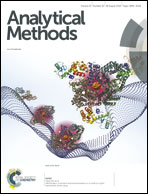A strategy to facilitate the assembly of DNA and upconversion nanoparticles for biosensor construction†
Abstract
Upconversion nanoparticles (UCNPs) have attracted increasing interest owing to their excellent properties in chem/bio sensing. And DNA is the most frequently used biomolecule to functionalize the nanoparticles. However, there is still an urgent need for an effective and convenient strategy to assemble DNA strands on UCNPs. Herein, we utilized polydopamine (PDA) to coat hydrophobic UCNPs by a water-in-oil microemulsion method, which were then assembled with DNA through hydrogen bonding and π–π stacking interactions between the nucleotides of DNA and the aromatic groups of the PDA shell on the surface of the UCNPs. This strategy exhibited several merits such as decreasing the random coordination between phosphates of the DNA backbone and lanthanide ions of the UCNP surface and retaining the intrinsic DNA biorecognition functions for targets. A proof-of-concept biosensor for carcinoembryonic antigen (CEA) based on luminescence resonance energy transfer (LRET) was constructed using CEA aptamer-stabilized silver nanoparticles (Apt-AgNPs) as the energy acceptor. Due to the strong affinity between CEA and its aptamer, the upconversion luminescence was recovered in a [CEA]-dependent manner. This facile assembly strategy can be extended to various targets and sensors by altering the aptamer.

- This article is part of the themed collection: Analytical Methods Recent HOT articles


 Please wait while we load your content...
Please wait while we load your content...